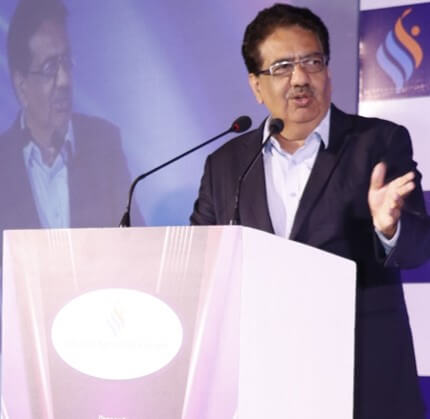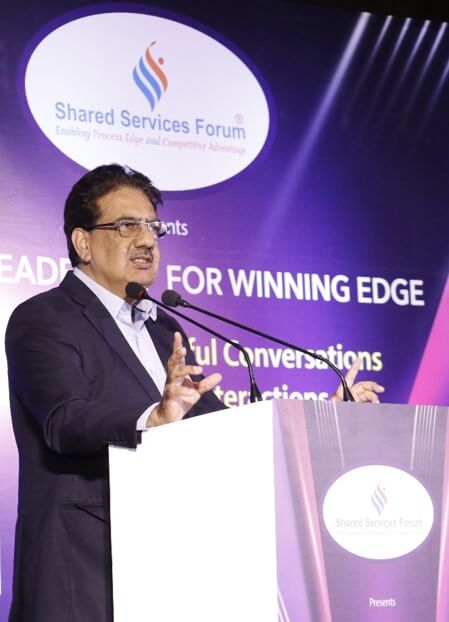Vineet Nayar, a “people’s magician” is considered one of the world’s foremost voices on human potential management, workplace transformation and high-speed business growth. He is an accomplished business leader, author of the critically acclaimed bestseller book ‘Employees First, Customer Second’, founder of Sampark Foundation, which has imparted education to 7 million children in rural India, an avid mentor to start-ups, and the former CEO of HCL Technologies Ltd, which is one of the largest and fastest growing IT services business companies in India.
Vineet’s ground-breaking “Employees First, Customers Second (EFCS)” philosophy which puts ‘humans’ at the centre of businesses, became a phenomenon in the business world. He implemented the EFCS philosophy at HCL Technologies for a successful turnaround.
Fortune magazine has described the company as having the “world’s most modern management”. Innovative management practices at HCL Technologies are taught as case studies at both the Harvard Business School as well as London Business School.

Vineet has been chosen by Fortune magazine for its first-ever global Executive Dream Team and featured on the elite Thinkers 50 list, a global community of business leaders. He was also selected as a ‘Global Thinker 2016’ by Foreign Policy magazine for ‘unplugging technology so kids can learn’.
Sampark Foundation, the organization he co-founded with his wife Anupama, is transforming learning outcomes for 7 million children at less than $1 per child per annum. The scale and impact of this transformation is now a case study at Harvard Business School.
Vineet was recently felicitated by SSF (Shared Services Forum) India, as “The Pioneering Business Leader in Global India” for his Creativity and Leading Global IT & ITeS Mission, Delivering Value and Impact to Business, Industry and Society. At the felicitation event, He spoke about the 5 mantras that lead to truly inspiring leadership and successful transformations. —ed.
I am a retired IT guy, though not retired from IT. I am using technology extensively to bring happiness to seven million children, and that is giving me a completely different kind of joy. It is a passionately joyful journey, which is what I have embarked on by leveraging innovation for achieving transformation – both to myself as well as to the society.
It is not about butterflies and ants, and not about successes and
failures, but about why it is better to attempt something new and fail
rather than attempt something which everybody else has done before.
The industrial era brought the science of management centre stage, delivering great results. The digital era, in contrast, demands high doses of innovation, which are not just process improvements. The leaders of today need to build organizations that have a culture of rapid experimentation and innovation. This needs inspired and freethinking leaders, not managers trapped in a monitoring and supervisory mindset.
I will start my narrative with a story and build the analogy as we go along....
The Story
There were once a bunch of ants sitting in a group and they were talking to each other about the joys of life. But they were really ambitious ants. One of them got up and said “you know what, I want to be the biggest CEO the world has seen, bigger than Jack Welch” and everybody clapped. The second ant then said “actually I'm a sports enthusiast and I want to be the fastest ant, faster than Usain Bolt.” The third ant said, “you guys are lazy, I’d like to be richer than Mukesh Ambani.” Soon all the ants were having these conversations and talking about their aspirations and feeling good about it. But there was this one Johnny ant which was looking outside the window with leg up and laughing her head off.
All the other ants went up to her and said, “What are you doing? Why are you laughing? Why are you ignoring all our aspirations and ambitious statements? You can learn a lot from that.” She turned to them saying “I'm laughing because I don't want to be an ant anymore. I want to be a butterfly. That way I will at least be a step better than merely sitting and just be happy in the idiocy of idle talk.”
The day a person recognizes that there are six billion ants in the world and being one more will not help you or the world, is the day you can start your transformation journey.
The Analogy
The word ‘transform’ is to change the form of something permanently. It is not incremental in nature. It is changing the structure of something permanently. If you want to be in the business of transformation - whether it is your life, whether it is your children's life, whether it is your team, whether it is your company - you cannot do that by being an ant. The first thing you need to ponder about is that if you wish to engage in transformation better than only at the conversational level, and want to think deeper about how it impacts you and the people around you, then you have to stop thinking like an ant.

So let us start this journey of trying to think about how we can transform ourselves and be butterflies in our own respective lives. Here let me tell you that it is not about butterflies and ants, and not about successes and failures, but about why it is better to attempt something new and fail rather than attempt something which everybody else has done before.
Here’s a framework for us to use. Since the world loves processes and structure, this here is a definitional framework to walk into the journey of transformation that you could potentially achieve at the end.
The Magician’s Framework
A high performance or a high impact individual or a team is one, which accomplishes that others consider impossible. The only way you can do what others consider impossible, is by attempting it long enough - and hard enough. By doing so you would have an opportunity to be a high-impact individual or a team - and hence a ‘butterfly’. The definition of impossible comes from a magician. When a magician does a trick in front of you he cuts a girl into half, lifts her off, throws sand on you and vanishes, or brings in a helicopter on the stage, you call it impossible.
Someone out there is waiting to throw you on a train you believe to
have missed, if only you decide to take that chance.

The reason you call the magic trick impossible is because it is outside your boundaries of logic and reason. But it is well within the boundaries of logic and reason of the magician. So the trick of mastering the impossible is to try and bring more and more things within your boundaries of logic and reason by stretching those boundaries. If you keep yourself, your thought, your actions, your aspirations and your ambition within the boundaries of logic and reason there is no way ‘impossible’ will happen - and there is no way transformation will happen.
So the inevitable question is: how do you stretch the boundaries of logic and reason despite the fact that everybody around you will tell you it is impossible? How do you learn the art of turning around to those people and say, “this is exactly why I'm doing it - because it is impossible”? How do you increase your chances of success in trying to make that possible? I have formulated these into five mantras. None of these are sure-shot ideas, but if you think around these, maybe it will trigger some thought in your mind for you to transform yourself and consider issues with a different tangent.
The Five Mantras for Inspired Leadership
-
Take those Chances and Chase an Impossible Train
The first originates from a story of my childhood, when I was about 7 years old. My father was an employee of National Environmental Engineering Research Institute at Nagpur. He got transferred a lot. He got a job in the university in Pantnagar which is in the foothills of the Himalayas. We were on a train journey from Nagpur to Pantnagar and the train stopped at Ratlam station. We were on a second class or third-class compartment at that particular time and it was pretty hot and somehow I was awake. I was on the topmost berth of the train with my two brothers. I decided to get down not only from my berth but from the train. I was at the platform and it was a fascinating view. My grandfather used to sell cigarettes on a station and he would take me whenever I went to his house on a holiday as a child. Since then railway stations have always fascinated me - because of humanity coming together in a form and shape which you don't see anywhere else. So while I was watching, fascinated with what was happening around me, the train began to move. I was pretty confident that I would be able to catch it because I was ‘cocky’, as any young lad would be at that age. I was confident and as you probably know, nothing has changed even now. So the moment the train started moving I started running behind the train. I caught hold of the pole and pulled myself up and fell! I realized that when you have running feet and you are a seven-year-old you don’t have the strength in the arm to pull yourself up on the train. So it was for the first time in my life that I experienced ‘doubt’. But I got up and decided to run after the train once again. This time I pushed myself harder, pulled myself harder, and fell harder! This is the first time a new word came to my head - fear.
I got up again push even harder, pulled even harder, and fell even harder. And now I experienced ‘panic’. Though it all happened in a few seconds, it was very clear that the train was running faster than I could run. It was clear that there is no way I could put myself on the train. Therefore, I had a choice to either stand and cry for help, or to run after that impossible train which I had no chance to catch. I don't know what came to my mind but I decided to run after the train. So I started running yet again and this time I had doubt, I had fear and I had panic and yet I ran behind the impossible train.
Have irrational expectations from yourself and everyone around you
who are with you in your journey of ‘impossible’.While I was running, from the corner of my eyes, I saw this lady - a vegetable vendor - who saw my plight, promptly caught hold of my shorts, and threw me on the last compartment of the moving train. Soon I was reunited with my parents. I don't know what life would be if I had not joined them.

I have always wondered why I kept running. Why did I take that chance despite fear, doubt and panic overpowering my mind? Did my taking the unlikely chance of running create the magic of someone helping me to get on the train? That lesson has stayed with me all my life - someone out there is waiting to throw you on a train you believe to have missed, if only you decide to take that chance.
The learning from the train incident has formed two basic principles in my life, which have been my guiding factors for achieving the impossible and dreaming unreasonable dreams. First - if you are not chasing impossible trains in life and taking chances, which appear to be impossible unreasonable and irrational, nobody will throw you on a train that you are missing. Secondly, if you are chasing impossible trains then somebody will come by and give you a hand to make it happen.
Therefore, the first mantra of doing the impossible and transforming your life, your teams, and your company is to take enough chances.
-
Dreaming an Irrational Dream
We were three brothers. I was still in school when we lost our father. There was a huge irrationality in the expectation, which my mother had from the family, that we will not just survive, but we as a family will do extremely well. There was never a doubt in our minds. I did not know what I would do. I did know however, that whatever I did it would be good for the society and me – and that’s how it all turned out. Therefore having irrationality of expectation is very important. This is different from what people call ‘ambition’. Ambition is a statement of intent and mere intent is not good enough. I believe that you will never fully achieve your aspirations if they are not irrational. If you are rational, if you can have expectations which can be computed on an Excel sheet - then forget the dream of becoming a butterfly, forget transformation. You will remain an ant. There has to be a complete irrationality of expectations from yourself first, to do the impossible.
I first joined HCL in 1985 and got fired in three months. As fate would have it, I was hired back in 2005 as the President of the company. I had this irrational dream of transforming the company, which was struggling at that time. We took it from US$ 2.3 bn market cap to about US$ 14 bn market cap by the time I quit, in 2013. Similarly, achieving the irrational is what we are doing at the Sampark Foundation – dreaming the impossible, and making it happen. The irrational expectation of the fact that we can transform learning outcomes for 7 million rural children in 76,000 schools was an impossible dream yesterday. Yet, that’s what we are doing at Sampark Foundation today.
Therefore, the second mantra to succeed is to have irrational expectations from yourself and everyone around you who are with you in your journey of ‘impossible’.
-
Power of Imperfection
The third idea is about imperfection. When you look around yourself, you will find that you are either resource-starved, or you don't have the right set of people, or the right amount of money, or you're not in the right market, or you don't have the right product, or the right mandate from the board.
That is what I call an ‘imperfect environment’. One of the many things, which people, who are ‘transformers’ realize, that they thrive in imperfect worlds - because if things were already perfect, there would be nothing required to be transformed, and there would be no success. For instance, what excites a diamond cutter, is the rough diamond, and not a polished diamond. A potter gets excited with rough clay, not with a made-up pot.
A ‘transformer’ will never complain about situations, or environment, or
lack of resource, or lack of attitude, or board approvals, or environmental
politics. Instead the transformer will sharpen the focus to achieve what is
‘impossible’ and ‘unreasonable’ in the face of ‘imperfection’.Therefore if you truly wish to transform your life or somebody else's life, or business profits, imperfection is what you should be looking for. There are a very few people who can navigate through imperfection. The art of getting excited about imperfection and converting an imperfect environment into positive results is the unique art of being a butterfly or being a transformer. The ants, when they see a wall in front of them, will turn right. A butterfly when they see a wall in front of them, will attempt to fly over the wall – for that was the reason they were born.
A ‘transformer’ will never complain about situations, or environment, or lack of resource, or lack of attitude, or board approvals, or environmental politics. Instead the transformer will sharpen the focus to achieve what is ‘impossible’ and ‘unreasonable’ in the face of ‘imperfection’. Imagine a plumber walking into a house where there is no leak, and therefore no job. What excites a plumber is a house with leaks, and if you want to be a plumber in life you have to learn the art of getting excited about houses with leaks. The day you spot a house with leaks, you will know why you were born. That’s the third mantra.
-
Culture of Innovation
 The fourth is a very interesting aspect about the manufacturing or the industrialization age. This is the science of management of putting people together and managing them for getting enhanced productivity from what a single individual can do. If one individual can produce one widget in a fixed period of time, putting 10 individuals together can produce a hundred, which is 10 times their individual capacity.
The fourth is a very interesting aspect about the manufacturing or the industrialization age. This is the science of management of putting people together and managing them for getting enhanced productivity from what a single individual can do. If one individual can produce one widget in a fixed period of time, putting 10 individuals together can produce a hundred, which is 10 times their individual capacity.The industrialization age was all about improving individual productivity and it brought a lot of wealth to many people. And then came the innovation age. The innovation age was about organizing people to get more per unit of human capital collectively, through new concepts and ideas. So the main question in front of us today is not how you put people together to drive productivity and efficiency but how you put people together to drive innovation. Most organizations that fail do so predominantly because they were always in the business of managing people and not inspiring people to innovate. There are no courses on how to inspire people.
If you want to be an innovative organization and do new things, and have a culture of innovation, then it is more important to inspire people than to manage them. And this is the idea that led to the birth of “Employees first, and Customers second”.
With the 35,000 employees in 2005, when I was appointed the President, to 2013, when I stepped down from the Board, HCL’s revenues, profits and market capitalization all increased by around 5x or more and that too on top of a large base, while the employee strength grew at around 3x. The secret was that the employees were inspired to innovate instead of being managed. The customer-facing employees were enabled to be in the business of creating unique experiences for our customers. We became an innovative organization, which grew faster than competition. We inverted the organizational pyramid and made the management accountable to the employees. Even my appraisal, for the 8 years while I was in HCL Technologies, was done by a hundred thousand employees and the results were published on the web for all to see.
It was a pre-declared Idea that I can be fired by the employees at any time. If my rating ever went below eight on a nine-point scale I would lose my right to inspire them. Any rating lower than that would make me lose the right to lead them; and therefore I would lose my job.
The fourth mantra therefore is that inspiration leads to innovation.
Let me pause and do a recap here. To me, the steps to success are – take chances with new ideas, have irrational expectations from yourself, get excited about imperfection, and then get into the business of inspiring people, and they will do the rest.
Let us take some examples here, of people who followed the above steps to get successes in life. Steve Jobs was called an obnoxious manager and very difficult to work with. The reason people would work for him is that he would push their benchmarks continuously upwards. He would take apart even a very good product design and redefine everything – the looks, the user interface – just to push his team to discover new thresholds for themselves and for every product. That is why Apple products are so beautiful and successful. Another example is Jack Welch. He believed and made it very clear to his teams that his terms of success was to be either number one or two in the industry, or he would sell the business. He sold every single business that was not industry number one or two in his 30 years’ tenure. During his tenure at GE, the company's value rose 4,000%. For both Steve and Jack, what worked was being irrational, taking chances, pushing the team, and inspiring them to do the impossible. Inspiration cannot be brought by taking the team to a beer bar. You inspire them by attempting to do something unique, which nobody else has done before – and creating the vision for it.
-
The Magic
This brings me to my last idea – that is the magic! When all the above – taking chances, having irrational expectations, getting excited with imperfections and inspiration – happen, magic comes together. It happens automatically. There is nothing that needs to be done specifically. These are things that ants don't do, but butterflies do.
The day you define for your team a vision, which is irrational,
which is impossible, and yet inspirational, that’s the day
everybody will believe in that vision.Let me tell you one more story to explain the magic. There was a grandmother, called Amma. She would walk up to a new-born child in the village and bless the child with a vision. If the child’s fingers were long - she would become an artist, or if the forehead was broad - she would become a scientist, or if the child had long legs - she would become an athlete. Everybody in the village believed in her vision. There was no rationality of the vision, there was no data, there was no analysis and yet when the grandmother picked up the child and defined a vision for that girl, everybody believed it. It was irrational. Yet everybody believed it - and that’s the magic of being a butterfly! The day you define for your team a vision, which is irrational, which is impossible, and yet inspirational, that’s the day everybody will believe in that vision. They may not believe in you for you are irrelevant, you are that obnoxious guy who keeps pushing, but they will certainly get inspired by the vision you have defined and that is the day the magic happens. That is the day a butterfly is born. That is the day our transformation takes place successfully.
Happy Transformation!
ABOUT THE AUTHOR

Vineet has laid down for us so simply and yet so powerfully a practical and highly implementable formula for success. It is perhaps wise for us to reflect and introspect as to how we could enable personal and business successes and motivate people to innovate. There is no doubt that leaders will benefit immensely by trying this time-tested framework or ‘magic’ to bring out their winning streak and inspire people to grow as leaders – and thereby enable effective transformation for fast business growth. In the world where “it is more important to inspire people than to manage them”, these five mantras hold the key to the challenges faced by any transformation leader. – ed.



 Ask an Expert
Ask an Expert



